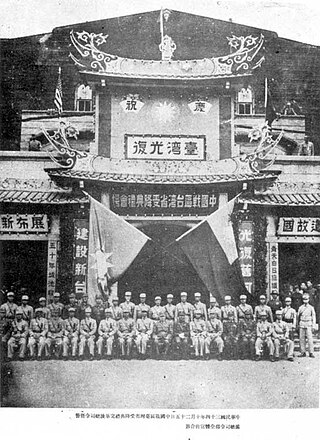
The Potsdam Declaration, or the Proclamation Defining Terms for Japanese Surrender, was a statement that called for the surrender of all Japanese armed forces during World War II. On July 26, 1945, United States President Harry S. Truman, United Kingdom Prime Minister Winston Churchill, and Chairman of China Chiang Kai-shek issued the document, which outlined the terms of surrender for the Empire of Japan, as agreed upon at the Potsdam Conference. The ultimatum stated that, if Japan did not surrender, it would face "prompt and utter destruction."

Japan was occupied and administered by the Allies of World War II from the surrender of the Empire of Japan on September 2, 1945, at the war's end until the Treaty of San Francisco took effect on April 28, 1952. The occupation, led by the American military with support from the British Commonwealth and under the supervision of the Far Eastern Commission, involved a total of nearly one million Allied soldiers. The occupation was overseen by the US General Douglas MacArthur, who was appointed Supreme Commander for the Allied Powers by the US President Harry S. Truman; MacArthur was succeeded as supreme commander by General Matthew Ridgway in 1951. Unlike in the occupations of Germany and Austria, the Soviet Union had little to no influence in Japan, declining to participate because it did not want to place Soviet troops under MacArthur's direct command. And unlike Germany, the Japanese government still remained in place throughout the occupation.

The Imperial General Headquarters was part of the Supreme War Council and was established in 1893 to coordinate efforts between the Imperial Japanese Army and Imperial Japanese Navy during wartime. In terms of function, it was approximately equivalent to the United States Joint Chiefs of Staff and the British Chiefs of Staff Committee.

The Empire of Japan, also referred to as the Japanese Empire, Imperial Japan, or simply Japan, was the Japanese nation-state that existed from the Meiji Restoration in 1868 until the enactment of the reformed Constitution of Japan in 1947. From 29 August 1910 to 2 September 1945, the Empire of Japan included the naichi and the gaichi. It also ruled colonies such as Kwantung, South Seas, Mantetsu, and its concessions. In the closing stages of World War II, with Japan defeated alongside the rest of the Axis, the formalized Japanese Instrument of Surrender was issued in compliance with the Potsdam Declaration of the victorious Allies; and Japanese territory immediately shrunk when lost Korea, Taiwan, Kuril, and Karafuto as it is today.

The Cairo Conference also known as the First Cairo Conference, one of the 14 summit meetings during World War II, took place on November 22–26, 1943. The Conference was held at Cairo in Egypt between China, the United Kingdom and the United States. It outlined the Allied position against the Empire of Japan during World War II and made decisions about post-war Asia. The conference was attended by Chairman Chiang Kai-shek, British Prime Minister Winston Churchill and US President Franklin D. Roosevelt.

The Japanese Instrument of Surrender was the written agreement that formalized the surrender of the Empire of Japan, marking the end of hostilities in World War II. It was signed by representatives from the Empire of Japan and from the Allied nations: the United States of America, the Republic of China, the United Kingdom of Great Britain and Northern Ireland, the Union of Soviet Socialist Republics, the Commonwealth of Australia, the Dominion of Canada, the Provisional Government of the French Republic, the Kingdom of the Netherlands, and the Dominion of New Zealand. The signing took place on the deck of USS Missouri in Tokyo Bay on 2 September 1945.

The Supreme Commander for the Allied Powers was the title held by General Douglas MacArthur during the United States-led Allied occupation of Japan following World War II. It issued SCAP Directives to the Japanese government, aiming to suppress its "militaristic nationalism". The position was created at the start of the occupation of Japan on August 14, 1945. It was originally styled the Supreme Commander of the Allied Powers.

The final battles of the European theatre of World War II continued after the definitive surrender of Nazi Germany to the Allies, signed by Field marshal Wilhelm Keitel on 8 May 1945 in Karlshorst, Berlin. After German leader Adolf Hitler's suicide and handing over of power to grand admiral Karl Dönitz on the last day of April 1945, Soviet troops conquered Berlin and accepted surrender of the Dönitz-led government. The last battles were fought on the Eastern Front which ended in the total surrender of all of Nazi Germany’s remaining armed forces such as in the Courland Pocket in western Latvia from Army Group Courland in the Baltics surrendering on 10 May 1945 and in Czechoslovakia during the Prague offensive on 11 May 1945.

The International Military Tribunal for the Far East (IMTFE), also known as the Tokyo Trial and the Tokyo War Crimes Tribunal, was a military trial convened on 29 April 1946 to try leaders of the Empire of Japan for their crimes against peace, conventional war crimes, and crimes against humanity, leading up to and during the Second World War. The IMTFE was modeled after the International Military Tribunal (IMT) at Nuremberg, Germany, which prosecuted the leaders of Nazi Germany for their war crimes, crimes against peace, and crimes against humanity.

The South-East Asian Theatre of World War II consisted of the campaigns of the Pacific War in the Philippines, Thailand, Indonesia, Indochina, Burma, India, Malaya and Singapore between 1941 and 1945.

The Casablanca Conference or Anfa Conference was held in Casablanca, French Morocco, from January 14 to 24, 1943, to plan the Allied European strategy for the next phase of World War II. The main discussions were between US President Franklin Roosevelt and British Prime Minister Winston Churchill. Stalin could not attend. Key decisions included a commitment to demand Axis powers' unconditional surrender; plans for an invasion of Sicily and Italy before the main invasion of France; an intensified strategic bombing campaign against Germany; and approval of a US Navy plan to advance on Japan through the central Pacific and the Philippines. The last item authorized the island-hopping campaign in the Pacific, which shortened the war. Of all the decisions made, the most important was the invasion of Sicily, which Churchill pushed for in part to divert American attention from opening a second front in France in 1943, a move that he feared would result in very high Allied casualties and not be possible until 1944.

The German Instrument of Surrender was a legal document effecting the unconditional surrender of the remaining German armed forces to the Allies, and ended World War II in Europe; the signing took place at 22:43 CET on 8 May 1945 and the surrender took effect at 23:01 CET on the same day.

Shigenori Tōgō was Minister of Foreign Affairs for the Empire of Japan at both the start and the end of the Axis–Allied conflict during World War II. He also served as Minister of Colonial Affairs in 1941, and assumed the same position, renamed the Minister for Greater East Asia, in 1945.
World War II officially ended in Asia on September 2, 1945, with the surrender of Japan on the USS Missouri. Before that, the United States dropped two atomic bombs on Japan, and the Soviet Union declared war on Japan, causing Emperor Hirohito to announce the acceptance of the Potsdam Declaration on August 15, 1945, which would eventually lead to the surrender ceremony on September 2.

The surrender of the Empire of Japan in World War II was announced by Emperor Hirohito on 15 August and formally signed on 2 September 1945, bringing the war's hostilities to a close. By the end of July 1945, the Imperial Japanese Navy (IJN) had become incapable of conducting major operations and an Allied invasion of Japan was imminent. Together with the United Kingdom and China, the United States called for the unconditional surrender of the Japanese armed forces in the Potsdam Declaration on 26 July 1945—the alternative being "prompt and utter destruction". While publicly stating their intent to fight on to the bitter end, Japan's leaders were privately making entreaties to the publicly neutral Soviet Union to mediate peace on terms more favorable to the Japanese. While maintaining a sufficient level of diplomatic engagement with the Japanese to give them the impression they might be willing to mediate, the Soviets were covertly preparing to attack Japanese forces in Manchuria and Korea in fulfillment of promises they had secretly made to the United States and the United Kingdom at the Tehran and Yalta Conferences.

The Flensburg Government, also known as the Flensburg Cabinet, the Dönitz Government, or the Schwerin von Krosigk Cabinet, was the rump government of Nazi Germany during a period of three weeks around the end of World War II in Europe. The government was formed following the suicide of Adolf Hitler on 30 April 1945 during the Battle of Berlin. It was headed by Grand Admiral Karl Dönitz as Reichspräsident and Lutz Graf Schwerin von Krosigk as the Leading Minister. The administration was referred to as the "Flensburg Government" because Dönitz's command had relocated to Flensburg in northern Germany near the Danish border on 3 May 1945. The sports school at the Mürwik naval academy was used as the government headquarters.

Retrocession Day is the name given to the annual observance and a former public holiday in Taiwan to commemorate the end of Japanese rule of Taiwan and Penghu, and the claimed retrocession ("return") of Taiwan to the Republic of China on 25 October 1945. However, the idea of "Taiwan retrocession" is in dispute.

This is the service summary of Douglas MacArthur, a General in the United States Army, who began his career in 1903 as a second lieutenant and served in three major military conflicts, going on to hold the highest military offices of both the United States and the Philippines.

The Allied Control Council (ACC) or Allied Control Authority, and also referred to as the Four Powers, was the governing body of the Allied occupation zones in Germany (1945–1949/1991) and Austria (1945–1955) after the end of World War II in Europe. After the defeat of the Nazis, Germany and Austria were occupied as two different areas, both by the same four Allies. Both were later divided into four zones by the 1 August 1945 Potsdam Agreement. Its members were the Soviet Union, the United Kingdom, the United States, and France. The organisation was based in Schöneberg, Berlin.

Far East Command (FECOM) was a unified combatant command of the United States Department of Defense, active from 1947 until 1957, functionally organised to undertake the occupation of Japan and Korea. The 1st and 6th Marine Divisions, who from 1945 to 1948 assisted the Chinese government in occupying northern China, disarming the Japanese, and helping the Kuomintang Chinese without fully getting involved in the Chinese Civil War, were not part of Far East Command and reported to Pacific Command and the U.S. Navy.


















